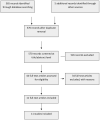Humeral and Glenoid Version in Reverse Total Shoulder Arthroplasty: A Systematic Review
- PMID: 36556031
- PMCID: PMC9781424
- DOI: 10.3390/jcm11247416
Humeral and Glenoid Version in Reverse Total Shoulder Arthroplasty: A Systematic Review
Abstract
There is increasing interest in reverse total shoulder arthroplasty (RTSA) as a reliable treatment for arthritic, rotator cuff deficient shoulders. Humeral and glenoid version are controversial parameters that can influence internal and external rotation, muscular forces, and implant stability as outcomes of RTSA. The aim of this study was to obtain an overview of the current knowledge on the effect of both humeral component version and glenoid component version and give recommendations on their most optimal degree for RTSA. A comprehensive quantitative review of the published literature on the effect of humeral version and glenoid version in RTSA was performed, to identify its influence on the range of movement, muscle forces, and intrinsic stability of the reverse prosthesis. Eleven studies were included: nine were biomechanical studies, one was a clinical-radiographic study, and one was an implant design consideration. Anterior stability can be improved by implanting the humeral component in neutral or with some anteversion. Glenoid component retroversion has been proven to reduce the likelihood of subluxation, while increasing ER and ROM at the same time. The study was conducted considering 5° anteversion; neutral; and 5°, 10°, and 20° retroversion of the glenoid component. Although a final opinion has not been yet expressed on the matter, the general consensus tends to agree on restoring 0° to 20° of retroversion of the humeral and glenoid component to yield the best outcomes.
Keywords: glenoid version; humeral version; muscle forces; range of motion; reverse prosthesis; reverse shoulder arthroplasty; stability.
Conflict of interest statement
The authors declare no conflict of interest.
Figures
Similar articles
-
Influence of glenoid component design and humeral component retroversion on internal and external rotation in reverse shoulder arthroplasty: a cadaver study.Orthop Traumatol Surg Res. 2013 Dec;99(8):887-94. doi: 10.1016/j.otsr.2013.08.008. Epub 2013 Nov 8. Orthop Traumatol Surg Res. 2013. PMID: 24211248
-
Does Humeral Component Version Affect Range of Motion and Clinical Outcomes in Reverse Total Shoulder Arthroplasty? A Systematic Review.J Clin Med. 2021 Dec 8;10(24):5745. doi: 10.3390/jcm10245745. J Clin Med. 2021. PMID: 34945040 Free PMC article. Review.
-
The effect of component positioning on intrinsic stability of the reverse shoulder arthroplasty.J Shoulder Elbow Surg. 2010 Jun;19(4):550-6. doi: 10.1016/j.jse.2009.11.044. Epub 2010 Mar 23. J Shoulder Elbow Surg. 2010. PMID: 20335055
-
Effect of humeral component version on impingement in reverse total shoulder arthroplasty.J Shoulder Elbow Surg. 2011 Jun;20(4):652-8. doi: 10.1016/j.jse.2010.08.020. Epub 2010 Dec 8. J Shoulder Elbow Surg. 2011. PMID: 21144775
-
[Current status and perspectives of shoulder replacement].Unfallchirurg. 1999 Sep;102(9):668-83. doi: 10.1007/s001130050465. Unfallchirurg. 1999. PMID: 10506358 Review. German.
Cited by
-
Three-dimensional planning, navigation, patient-specific instrumentation and mixed reality in shoulder arthroplasty: a digital orthopedic renaissance.EFORT Open Rev. 2024 Jun 3;9(6):517-527. doi: 10.1530/EOR-23-0200. EFORT Open Rev. 2024. PMID: 38828974 Free PMC article. Review.
-
Mid-term results of the use of structural humeral head autograft to correct glenoid bone loss in reverse total shoulder arthroplasty.JSES Int. 2023 Sep 22;8(1):132-140. doi: 10.1016/j.jseint.2023.08.018. eCollection 2024 Jan. JSES Int. 2023. PMID: 38312272 Free PMC article.
-
Accuracy of implant placement after preoperative planning using Blueprint software in inlay and onlay reverse total shoulder arthroplasty systems: a cadaver study.J Shoulder Elbow Surg. 2025 Jun 26:S1058-2746(25)00488-4. doi: 10.1016/j.jse.2025.05.019. Online ahead of print. J Shoulder Elbow Surg. 2025. PMID: 40581086
-
Influence of Lateralization and Distalization on Joint Function after Primary Reverse Total Shoulder Arthroplasty.Bioengineering (Basel). 2023 Dec 11;10(12):1409. doi: 10.3390/bioengineering10121409. Bioengineering (Basel). 2023. PMID: 38136000 Free PMC article.
-
Increased glenoid baseplate retroversion improves internal rotation following reverse shoulder arthroplasty.JSES Int. 2024 Aug 28;9(1):147-154. doi: 10.1016/j.jseint.2024.08.185. eCollection 2025 Jan. JSES Int. 2024. PMID: 39898228 Free PMC article.
References
LinkOut - more resources
Full Text Sources



